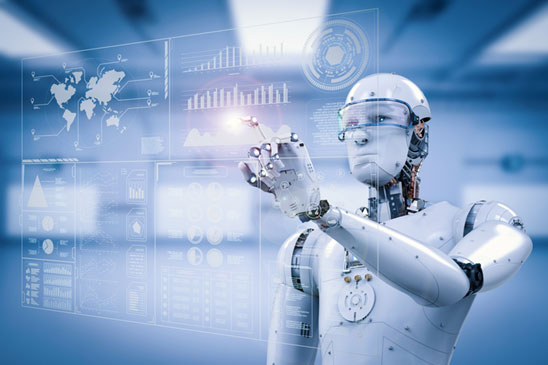The Basics of AI
Artificial Intelligence (AI) is a branch of computer science that is concerned with the development of intelligent machines that can think, perceive, reason, and act much like humans. AI encompasses a variety of technologies and techniques, such as machine learning, natural language processing, computer vision, and robotics. AI has been used in many applications, such as medical diagnosis, game playing, stock trading, self-driving cars, and natural language understanding. By leveraging the principles of AI, machines can be used to gain insights from data, identify patterns, and make decisions that are more accurate and reliable than those made by humans alone. AI also plays an increasingly important role in the development of autonomous systems, which can interact with the environment and make decisions without direct human.
What is AI and How is it Used?
Artificial intelligence (AI) is a rapidly developing field of technology that seeks to create machines that are capable of performing tasks that would normally require human intelligence. This includes tasks such as problem-solving, decision-making, natural language processing, and computer vision. AI has been applied to a wide range of fields, including robotics, finance, healthcare, and education. AI technology can be used to automate mundane or tedious tasks, such as sorting through data to find patterns or making decisions based on data. With the use of AI, businesses can gain insights from large datasets, optimize processes, and create more personalized services for customers. AI can also be used to create virtual assistants that can respond to users’ queries and commands.
Benefits of Artificial Intelligence (AI)

Device
The utilization of Artificial Intelligence (AI) has become increasingly prevalent in recent years, as the technology has grown in sophistication and capability. AI systems can be used to automate mundane tasks, such as sorting data, performing calculations, and providing feedback. Additionally, AI can be used to create models and simulations which can be used to predict outcomes and analyze complex scenarios. This can provide businesses and organizations with valuable insight, enabling them to make informed decisions and increase their efficiency. Furthermore, AI can be used to drive innovation, as it can be used to develop new products and services that may have previously been impossible. AI is also being used to improve customer service, as it can provide personalized responses and answer customer inquiries quickly and accurately.
Risks of Artificial Intelligence (AI)
The emergence of Artificial Intelligence (AI) has brought about a number of concerns regarding the potential risks it may pose. AI is an expansive and rapidly evolving technology, and as such, there is still much to learn about it and its implications. While AI has the potential to positively impact many aspects of our lives, its widespread use, and potential misuse, also brings with it a number of potential risks. These risks range from AI-related privacy and security risks, to economic and employment risks, to ethical and societal risks. When it comes to privacy and security, AI-enabled systems can be vulnerable to a variety of threats, such as data breaches, malicious actors, and malicious algorithms that can exploit weaknesses in their programming.
Artificial Intelligence (AI) Applications

Artificial Intelligence (AI) has become an increasingly important field of study in the past few decades, with applications having the potential to revolutionize the way we live, work, and think. AI applications are designed to enable machines to mimic human intelligence in a variety of ways, such as recognizing objects, understanding and responding to natural language, and making decisions based on a set of rules. AI technology is being used in a variety of industries, ranging from healthcare to finance to transportation, and has the potential to reduce costs, increase productivity, and improve customer service. AI applications can be used to identify patterns and trends in data that would otherwise be difficult to detect, and can be used to automate processes that would otherwise require significant manual effort.
Automated Machine Learning
Automated Machine Learning (AutoML) is a rapidly developing subfield of Artificial Intelligence (AI) and Machine Learning (ML). It is equivalent to the “programming of programs” that was once the exclusive domain of software developers. AutoML is designed to make the process of creating, deploying, and managing ML models easier and faster, while also reducing the need for manual intervention or coding. AutoML leverages modern ML algorithms and techniques such as supervised and unsupervised learning, deep learning, and reinforcement learning to automate the entire model development process, from data pre-processing to model selection and deployment. This helps to reduce the time, cost, and effort associated with building and managing ML models.
Robotic Process Automation

Robotic Process Automation (RPA) refers to the use of technology to enable machines to mimic the actions of humans performing various tasks. This technology relies on software robots, or bots, that can be programmed to handle a variety of tasks, ranging from data entry to analysis and report generation. By relying on bots instead of humans, organizations can reduce costs, increase efficiency, and improve accuracy. RPA can also help automate mundane, repetitive tasks, freeing up human resources to focus on higher-value activities. It has been used in a variety of industries, including finance, health care, retail, and government. RPA has the potential to transform the way businesses operate, as it has the capacity to automate complex processes that involve multiple steps.
Conclusion
In conclusion, Artificial Intelligence (AI) is an area of research that has seen a tremendous surge in recent years, and is likely to continue to grow in relevance and importance in the near future. AI has been used to solve a wide range of problems related to areas such as robotics, natural language processing, computer vision, and machine learning, among others. The potential applications of AI are vast, and the technology is being used to develop new ways to enhance and improve the way we interact with the world around us. AI technologies are being used to automate mundane and repetitive tasks, create personalized experiences, develop intelligent systems that can identify patterns and trends in data, and even provide insights into complex problems.






